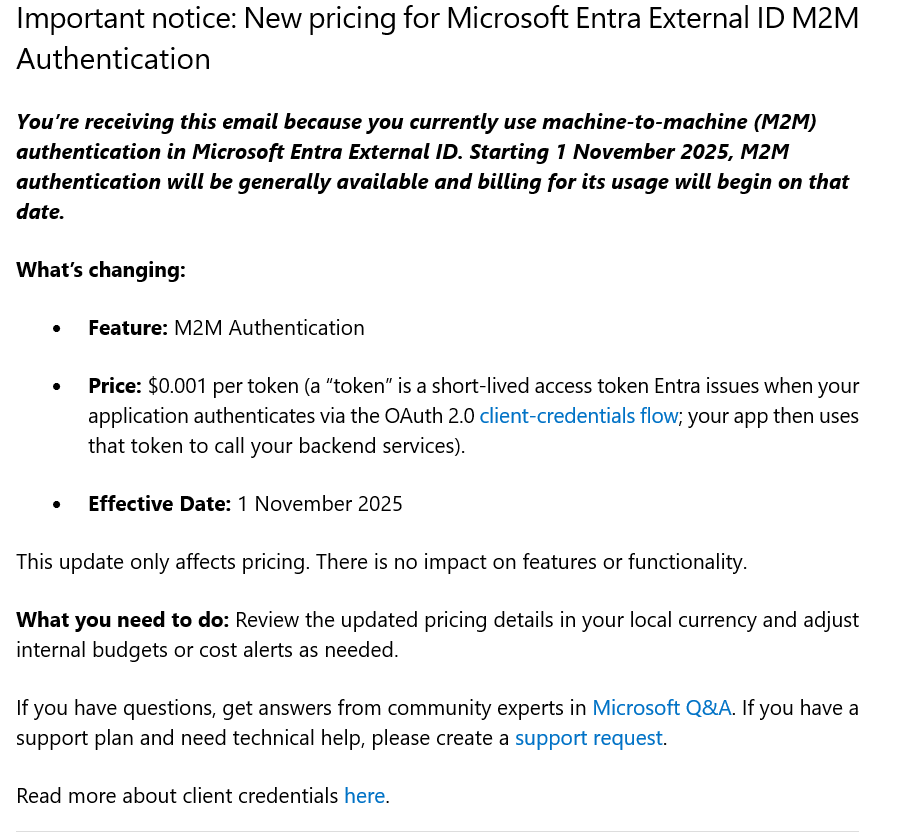Microsoft Just Put a Price Tag on Your M2M Tokens for Entra External ID
Microsoft just announced pricing for Microsoft Entra External ID M2M Authentication.
Starting November 1, 2025, every access token issued via the Client Credentials Flow will cost $0.001.
The feature isn’t going away — it’s simply entering its “production maturity” phase.
It’s time to pay more or less.

🔍 Quick Refresher: What’s M2M?
Machine-to-Machine (M2M) authentication enables applications to communicate securely without human interaction.
- The app authenticates using its client ID and secret or certificate.
- Entra External ID issues a short-lived access token (usually 1 hour).
- The app presents the token to access another service or API.
That’s the OAuth 2.0 Client Credentials Flow.
Common examples:
- A nightly sync job calling an internal API.
- A backend service interacting with Microsoft Graph.
- A microservice calling another internal API.
💸 The Math: Small Cost, Big Scale
At first glance, $0.001 per token sounds trivial.
Let’s test that assumption.
🧩 Example 1: Low-frequency app
A job runs once nightly and eight times during the day:
- 9 tokens/day × 30 days = 270 tokens/month
- 270 × $0.001 = $0.27/month
🔁 Example 2: High-frequency microservice
Negligible, right?
But scale it up with multiple services, environments (dev/stage/prod), or poor implementation — and it adds up.
The "Bad API Client" Pattern
public class BadApiClient
{
private readonly HttpClient _httpClient = new HttpClient();
private readonly string _scope = "https://graph.microsoft.com/.default";
private readonly string _tenantId = "<tenant_id>";
private readonly string _clientId = "<client_id>";
private readonly string _clientSecret = "<client_secret>";
public async Task<HttpResponseMessage> GetUserAsync(string userId)
{
// ❌ Fetches a new token for every request
var credential = new ClientSecretCredential(_tenantId, _clientId, _clientSecret);
var token = await credential.GetTokenAsync(new TokenRequestContext(new[] { _scope }));
var request = new HttpRequestMessage(HttpMethod.Get, $"https://graph.microsoft.com/v1.0/users/{userId}");
request.Headers.Authorization = new AuthenticationHeaderValue("Bearer", token.Token);
return await _httpClient.SendAsync(request);
}
}
Every call requests a new token. If this runs at 10 requests/sec, that’s 36'000 tokens/hour -> $864/day Design for efficiency — or pay for inefficiency.
🧭 Well-Architected Lens: How to Respond
The Azure Well-Architected Framework provides some help.
Let's focus on cost optimization and security:
💰 Cost Optimization
- Audit your applications: Identify all app registrations using the Client Credentials Flow. Check for app registrations with client secrets or certificates in entra external id.
- Cache tokens: Reuse tokens for their valid lifetime — never fetch on every request. Use a distributed cache in distributed systems.
- Measure usage: Check Sign-Ins Logs -> Service Principals sign-ins to track token issuance volume.
- Set alerts: Add cost anomaly detection to catch unexpected spikes early.
- Simulate costs: Multiply your average token count by $0.001 to predict your future budget impact.
🔐 Security
- Balance token lifetime vs. security: Don’t make tokens live forever, but don’t make them expire every 5 minutes either.
- Rotate secrets and certificates frequently — automation is your friend.
- Prefer Managed Identities: They remove secrets entirely and provide least-privilege access by design.
✅ Final notes
This isn’t bad news — it’s a maturity signal. For small workloads, the cost is noise. For large-scale systems, it’s a wake-up call to build well-architected and consider best practice.
